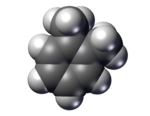o-Xylene
| |||
| Names | |||
|---|---|---|---|
| Preferred IUPAC name
1,2-Xylene | |||
| Systematic IUPAC name
1,2-Dimethylbenzene | |||
| Other names
o-Xylene | |||
| Identifiers | |||
| 95-47-6 | |||
| 3D model (Jmol) | Interactive image | ||
| ChEBI | CHEBI:28063 | ||
| ChEMBL | ChEMBL45005 | ||
| ChemSpider | 6967 | ||
| DrugBank | DB03029 | ||
| ECHA InfoCard | 100.002.203 | ||
| KEGG | C07212 | ||
| RTECS number | ZE2450000 | ||
| UNII | Z2474E14QP | ||
| |||
| |||
| Properties | |||
| C8H10 | |||
| Molar mass | 106.17 g·mol−1 | ||
| Appearance | Colorless liquid | ||
| Density | 0.88 g/ml | ||
| Melting point | −24 °C (−11 °F; 249 K) | ||
| Boiling point | 144.4 °C (291.9 °F; 417.5 K) | ||
| 0.02% (20°C)[1] | |||
| Solubility in ethanol | very soluble | ||
| Solubility in diethyl ether | very soluble | ||
| Vapor pressure | 7 mmHg (20°C)[1] | ||
| Refractive index (nD) |
1.50545 | ||
| Viscosity | 1.1049 cP at 0 °C 0.8102 cP at 20 °C | ||
| Structure | |||
| 0.64 D [2] | |||
| Hazards | |||
| Safety data sheet | See: data page External MSDS | ||
| EU classification (DSD) |
Harmful (Xn) Flammable (F) | ||
| R-phrases | R11 R20 R21 R38 | ||
| S-phrases | S25 | ||
| NFPA 704 | |||
| Flash point | 32 °C (90 °F; 305 K) | ||
| 463 °C (865 °F; 736 K)[3] | |||
| Explosive limits | 0.9%-6.7%[1] | ||
| 100 ppm[3] (TWA), 150 ppm[3] (STEL) | |||
| Lethal dose or concentration (LD, LC): | |||
| LCLo (lowest published) |
6125 ppm (rat, 12 hr) 6125 ppm (human, 12 hr)[4] | ||
| US health exposure limits (NIOSH): | |||
| PEL (Permissible) |
TWA 100 ppm (435 mg/m3)[1] | ||
| REL (Recommended) |
TWA 100 ppm (435 mg/m3) ST 150 ppm (655 mg/m3)[1] | ||
| IDLH (Immediate danger) |
900 ppm[1] | ||
| Related compounds | |||
| Related aromatic hydrocarbons |
m-xylene p-xylene toluene | ||
| Supplementary data page | |||
| Refractive index (n), Dielectric constant (εr), etc. | |||
| Thermodynamic data |
Phase behaviour solid–liquid–gas | ||
| UV, IR, NMR, MS | |||
| Except where otherwise noted, data are given for materials in their standard state (at 25 °C [77 °F], 100 kPa). | |||
| | |||
| Infobox references | |||
o-Xylene (ortho-xylene) is an aromatic hydrocarbon, based on benzene with two methyl substituents bonded to adjacent carbon atoms in the aromatic ring (the ortho configuration).
It is a constitutional isomer of m-xylene and p-xylene.
o-Xylene is largely used in the production of phthalic anhydride, and is generally extracted by distillation from a mixed xylene stream in a plant primarily designed for p-xylene production.
See also
References
- 1 2 3 4 5 6 "NIOSH Pocket Guide to Chemical Hazards #0668". National Institute for Occupational Safety and Health (NIOSH).
- ↑ Rudolph, H.D.; Walzer, K.; Krutzik, Irmhild (1973). "Microwave spectrum, barrier for methyl rotation, methyl conformation, and dipole moment of ortho-xylene". Journal of Molecular Spectroscopy. 47 (2): 314. doi:10.1016/0022-2852(73)90016-7.
- 1 2 3 "o-Xylene". International Chemical Safety Cards. ICSC/NIOSH. July 1, 2014.
- ↑ "Xylene (o-, m-, p-isomers)". Immediately Dangerous to Life and Health. National Institute for Occupational Safety and Health (NIOSH).
This article is issued from Wikipedia - version of the 9/4/2016. The text is available under the Creative Commons Attribution/Share Alike but additional terms may apply for the media files.


